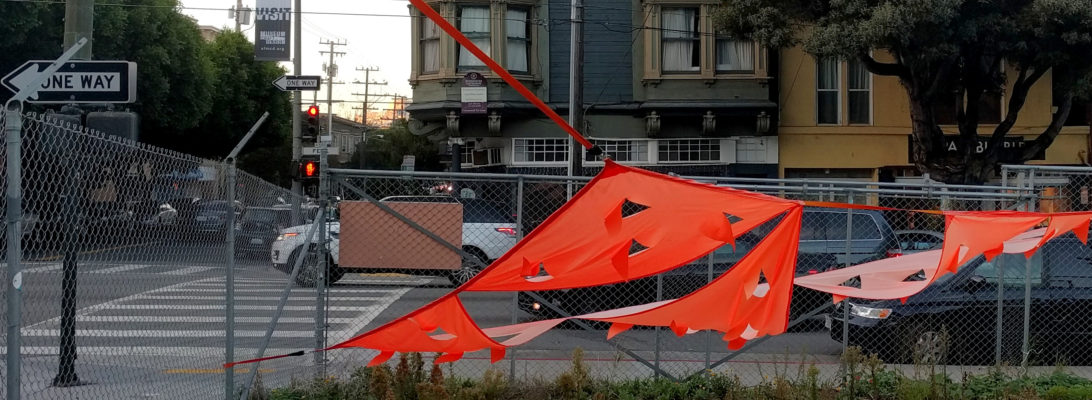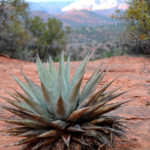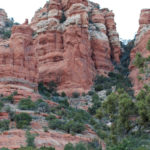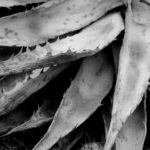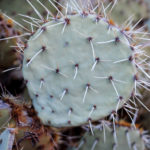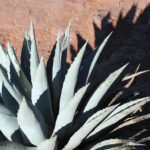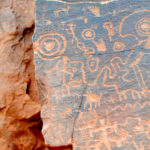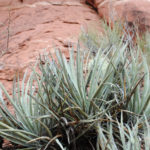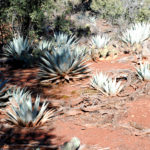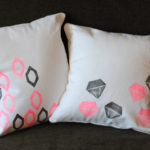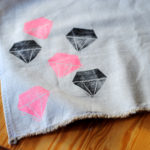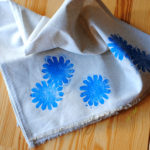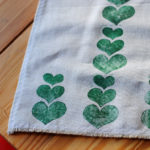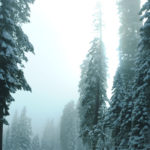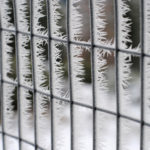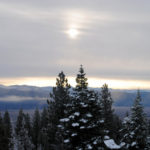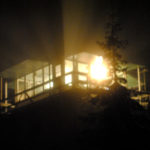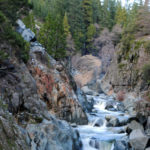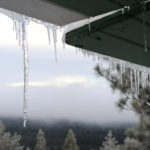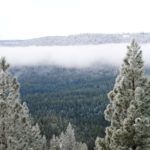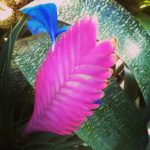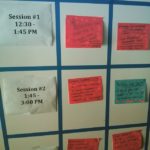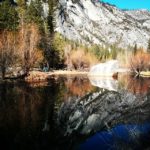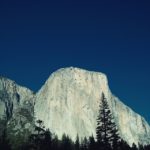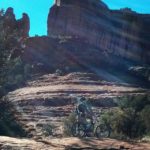I toted my camera along with me on a walk to the Post Office the other day. It was about 3 in the afternoon, with scudding white clouds across a blue sky – very warm temperatures. Between the clouds (instead of fog) and the temperature, it was hard to believe that is Janauary and that its San Francisco. Come with me on a walk down Geary and through Japantown.

Man checks the 38 MUNI Schedule
This isn’t one of San Francisco’s most beautiful neighborhoods. The huge road cutting through doesn’t help. Most of the walk is up against rather monolithic structures.

This is a charter school that butts up to the sidewalk. There isn’t any landscaping, and its always dirty. There is a colorful and large mosaic along the east end of the building.

The playground and open space/rec center at the corner is under construction. It was always kind of a wierd place. There are kids playing, soccer fields, but if you go by early in the morning, its obviously a major spot for people who are sleeping out, using the bathrooms, and sheltering. That whole stretch of Geary features a lot of abandoned food containers, suitcases, rough clothing, and shopping carts. Now there’s less, since the whole park area is blocked off. Maybe its because there aren’t any homes on that stretch of Geary, and no one is around to get them kicked out, that people feel its a good spot to hunker down.

There’s a lot, LOT of broken glass from car windows along Geary here.

Geary is a real scar on the landscape, especially with the strange undertunnels, but there are still some things to look at. I always liked the “California” paint on the side of the Boom Boom Room’s building.

The whole area was obviously developed (or should I say, redeveloped?) at another time. It echoes a lot of Eastern Bloc shape memories. Even the “Japanese” style landmarks are cast concrete, and the type of apartment towers in the background don’t show up in many other neighborhoods.

I walk up over one of the pedestrian overpasses. Geary has a couple of these, and they’re weird. Not many people use them. You either have to rotate up a super long winding accessible ramp, or tramp up a bunch of stairs. Its quicker to wait and cross at the crosswalk. Looking down from halfway up, you can see the general flavor of the pedestrian experience on this part of Geary – leftover. Trashed. Unattractive. Gray.

This pedestrian overpass is styled with Japanese (?) style lampposts to let you know where you are, I guess.

One was broken. Its a CFL.

Looking down onto Geary…you can see how easy it would be to add BRT or light rail! It would make commuting so much easier. Instead, its a huge paved slice. At this time of day, its not even that busy.

See? A little burst of traffic, then no traffic on all that open space. But we can’t use it for anything else, noooo!

It stinks up here on the pedestrian overpass, too much diesel fumes. Time to head down…I’ve crossed the border! Now I’m on the north side of Geary, I’m officially in Japantown.

Its pretty quiet over here mid-afternoon. Just some retirees, school kids, and people doing their daily work and errands. Some Nijiya Market employees are enjoying a late lunch in the sun on the loading dock. There are some great old signs.

Part of the whole 1960s style redesign here is this odd little village-style pedestrian only street. San Francisco DOES have pedestrian only street! Oh, does it count if it’s only a block long? Oh well. I still like it. Its a little cold, and grey though … and the fountain’s been off for a long time. Drought?

Some more fun signs on the “pedestrian street”…

This one is pretty serious! Watch out, old ladies who love feeding pigeons – you are not allowed to feed them in front of the hardware store….or else….

Walk across the street with me to Peace Plaza, perched right over Geary, in between sections of the Japantown Mall.

Is that concrete I spy? Why yes it is! Because there’s nothing more pleasant to sit on in cold, foggy San Francisco than a concrete plaza, right over a giant 8-10 lane road. So much gray, so little permeable surface! I imagine a green river looping right through the middle of this photo, planted with moss, and ferns.

Furniture outside the entrance to the mall surprised me. Hulking assymetrical cast concrete benches, angularly elbowing us with their pointy armrests, actually have warm, weathered seats made of natural wood. Who knew? Onward, into the mall! Its never terribly busy. Lots of fun stores and restaurants, that would bask in street frontage and passersby, but they’re locked away in a dated mall. I do love animal-headed babies, though….

Its late afternoon so the sunlight hits the buildings facing south in a nice way. This classic SF apartment building sits on Post Street, as I walked back home (enough of Geary, thank you).

But what’s this, right next to our friend with the nice trim and window finishes?

Its…a beige box next to its friend, the gray box? Wait, is that supposed to be someone’s house? I spy a rare bird though, a balcony in San Francisco. Along own Post street, here’s another juxtaposition – a small, wooden apartment building in faded pink huddles under the cold shoulder of a concrete box (with floor to ceiling windows no less).

I could make a comment about the contrast of the uninspired and sure-to-age-poorly condos going up all over SF right now, but these buildings are so much older. Probably the 1910s and the 1960s. Guess people have valued ROI and using every/last/scrap of building footprint more than creating a beautiful city and livable homes for a long time then….

Finally, a shot of a colorful mural along Post, on the side of the Rec Center. SF has a lot of potential for murals and color…more would be lovely. Some neighborhoods have absolutely none.
Thanks for walking with me, now headed to the Western Addition Library then down the street to my apartment.
